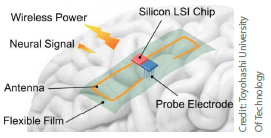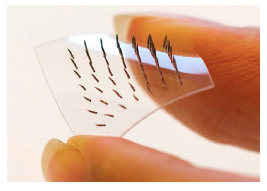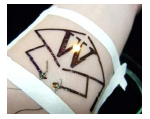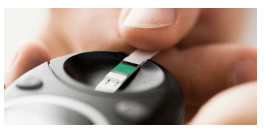Implant Wirelessly Supplies Power to the Brain
Trend Watch: Micro Patches, Implants, and Microscopic 3D Printing Enhance Healthcare
A research team at the Department of Electrical and Electronic Information Engineering at Toyohashi University of Technology has developed a wafer-level packaging technique to integrate a silicon large-scale integration (LSI) chip in a very thin film of a thickness  10 μm. The researchers have fabricated a wireless power transmission (WPT) device, including a flexible antenna and rectifier chip, by using a flip-chip bonding method.
10 μm. The researchers have fabricated a wireless power transmission (WPT) device, including a flexible antenna and rectifier chip, by using a flip-chip bonding method.
The majority of the fabricated device — 27 mm × 5 mm — is composed of a flexible film allowing it to fit the shape of the brain surface. In addition, researchers achieved WPT to the device when immersed in saline.
This WPT device can supply electricity to other circuits included in the neural interface. Researchers are trying to integrate more functions, for example amplifiers, analog-to-digital converters, signal processors, and radio frequency circuits to an LSI chip.
Skin Patch with Microneedles Proves Effective Alternative to Injections
 Scientists at the KTH Royal Institute of Technology in Stockholm, Sweden, have developed a new flexible microneedle patch that resolves some of the limitations of similar existing devices. The KTH team developed a composite device that consists of a soft base made from a polymer and rigid stainless needles that penetrate the skin.
Scientists at the KTH Royal Institute of Technology in Stockholm, Sweden, have developed a new flexible microneedle patch that resolves some of the limitations of similar existing devices. The KTH team developed a composite device that consists of a soft base made from a polymer and rigid stainless needles that penetrate the skin.
“To the best of our knowledge, flexible, and stretchable patches with arrays of sharp and stiff microneedles have not been demonstrated to date," says Frank Niklaus, a professor of micro and nanofabrication at KTH, in a statement.
The team built two versions of the patch, one more flexible than the other. The more stretchable device showed excellent pliability and each of its 50 needles successfully penetrated the skin in a 30-minute test. If the technology proves itself in additional studies, it may help make microneedle patches considerably more common and applicable to a variety of patients and conditions.
New Method for Integrating Flexible Electronics Into Skin Patches
 At the Waseda University in Japan, researchers have come up with a new, cheaper way of producing electronic devices that are flexible, elastic, and adhere to the skin.
At the Waseda University in Japan, researchers have come up with a new, cheaper way of producing electronic devices that are flexible, elastic, and adhere to the skin.
This development may help body monitoring electronic skin patches that interface with smartphone apps to become commonly used in medicine and by consumers.
The technology relies on elastomeric films only 1 μm thick that can safely contain electronic components sandwiched between them. An inkjet printer is used to put down lines of silver for wiring the components together. Importantly, there’s no soldering or gluing involved, which allows for a thinner final product that is highly flexible without fear of damage to the electrical connections.
The team demonstrated the technology by integrating an electronic chip and an LED into a patch that easily conforms to the skin and continues working for extended time periods.
The study of this method is published in Journal of Materials Chemistry C.
Medtronic Pumps Link to Accu-Chek Blood Glucose Meters via Bluetooth
 Roche Diabetes Care has created a new Bluetooth version of its Accu-Chek Guide blood glucose monitoring system (BGM), which will be integrated in some of Medtronic’s future insulin pumps. The Accu-Chek Guide is one of the two next-generation BGMs Roche diagnostics is developing, along with the Accu-Chek Instant. The Accu-Chek Guide received FDA approval in the United States in August 2016 but is not yet available in the UK. Under the new partnership with Medtronic, Roche will design the wireless BGM, called Accu-Chek Guide Link, with the newest Bluetooth Low Energy (BLE) technology. The BLE allows for low-energy connectivity to the associated Accu-Chek Connect diabetes management app and online portal.
Roche Diabetes Care has created a new Bluetooth version of its Accu-Chek Guide blood glucose monitoring system (BGM), which will be integrated in some of Medtronic’s future insulin pumps. The Accu-Chek Guide is one of the two next-generation BGMs Roche diagnostics is developing, along with the Accu-Chek Instant. The Accu-Chek Guide received FDA approval in the United States in August 2016 but is not yet available in the UK. Under the new partnership with Medtronic, Roche will design the wireless BGM, called Accu-Chek Guide Link, with the newest Bluetooth Low Energy (BLE) technology. The BLE allows for low-energy connectivity to the associated Accu-Chek Connect diabetes management app and online portal.
This Accu-Chek BGM is then meant to communicate with Medtronic’s future pumps. But, only pumps commercialized in markets covered by the agreement, which have not yet been revealed, will benefit from the enhanced capability.
Augmented Reality Guides ENT surgery
Scopis, a company headquartered in Berlin, Germany, won FDA clearance for its augmented reality navigation system for ENT surgeries. The technology provides visual guided paths, superimposed onto the live imaging from the endoscope, that help surgeons guide their tools safely toward difficult-to-reach targets. The technology relies on Scopis’s Hybrid Navigation platform that tracks the head in real-time using optical and electromagnetic techniques, automatically aligning previously captured imagery with real-time data coming from the scope. The optical and electromagnetic techniques can be used individually or together, depending on needs and the surgical instruments being used at the time.
Web-based App Allows Physicians to Interact with a Product
 PeerSourcing Solutions has introduced PharmAtype Brand Ideas, a crowdsourcing Web-based application that allows physicians to log on and interact with a product. All of the healthcare professionals’ responses are collected and analyzed via natural-language AI and machine learning. The output is the specific brand personality revealed by how the doctors reacted to the product. The company, which is neither an ad agency nor a makrket research firm, is headed by Maureen Regan, Brendan Ward, and Richard Campbell.
PeerSourcing Solutions has introduced PharmAtype Brand Ideas, a crowdsourcing Web-based application that allows physicians to log on and interact with a product. All of the healthcare professionals’ responses are collected and analyzed via natural-language AI and machine learning. The output is the specific brand personality revealed by how the doctors reacted to the product. The company, which is neither an ad agency nor a makrket research firm, is headed by Maureen Regan, Brendan Ward, and Richard Campbell.
“The results of our studies show that doctors’ responses indicate the same personality across borders," Ms. Regan says. “So, pharma marketers may finally be able to put an end to global turf wars and speak with a single voice around the world."
“We’re in the brand-idea business," Mr. Ward says. “We curate the work of experienced creatives whom we have trained to handle our specialized input."
Walmart Upgrades App to Add Pharmacy Refills
 Walmart has updated its app, and made big changes to the pharmacy features. With the new updates, users can refill prescriptions, track their order, and view price and pickup details. Walmart is also introducing express lanes to speed customers who are using the app through the pharmacy pickup line. Users just scan a code at the register and pick up the prescription — payment and receipts all happen through the app.
Walmart has updated its app, and made big changes to the pharmacy features. With the new updates, users can refill prescriptions, track their order, and view price and pickup details. Walmart is also introducing express lanes to speed customers who are using the app through the pharmacy pickup line. Users just scan a code at the register and pick up the prescription — payment and receipts all happen through the app.
The upgrade also lets users sign off on medical forms and view prescription pricing on the application. In addition to the pharmacy changes, the app will work with the retailer’s 1,200 wire-transfer centers, letting customers cash checks, pay bills, and send money without paperwork.
Scientists Develop 3D Vascular Networks for Building Living Tissues
Researchers at University of California, San Diego, have developed a method of printing tiny (4 mm × 5 mm, 600 μm thick), pre-designed vascular networks that turn into vessel-like structures made of the same cells as natural blood vessels.
The new method, called microscale continuous optical bioprinting (μCOB), involves embedding a mix of different kinds of live cells into a hydrogel and then using ultraviolet light and mirrors to heat up and solidify 3D patterns within the hydrogel. The living cells that are left untouched, and that are inside the newly created structure, eventually settle in and grow new cells.
These structures were implanted onto the wounds of mice, which bonded together and the mouse tissue connected its vascular network with the man-made one, letting blood flow through it as though it is its own. (PV)



















